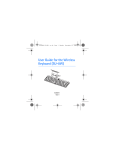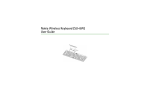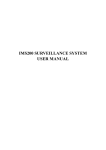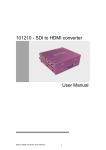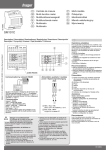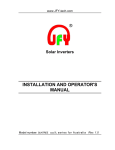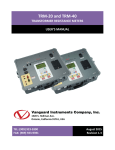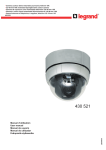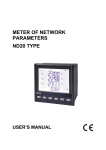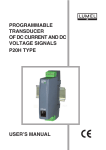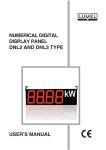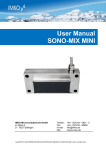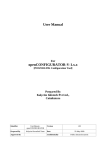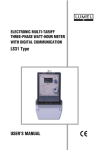Download USER`S MANUAL P41 TYPE
Transcript
PROGRAMMABLE TRANSDUCER OF 1-PHASE POWER NETWORK PARAMETERS P41 TYPE USER’S MANUAL 1 P 41 -0 9 Use r's ma nu a l 2 Contents 1 APPLICATION......................................................................................................................3 2 TRANSDUCER SET.............................................................................................................3 3 BASIC REQUIREMENTS AND OPERATIONAL SAFETY...................................................3 4 INSTALLATION.....................................................................................................................4 4.1 Way of fixing..................................................................................................................4 4.2 External connections diagram.......................................................................................5 5 SERVICE..............................................................................................................................6 5.1 Description of the frontal plate......................................................................................6 5.2 Signaling the state after switching the supply on.........................................................6 5.3 Installation of port COM drivers on a computer............................................................6 5.4 Transducer configuration using LPCon.........................................................................8 5.4.1 Setting the tramsmission parameters .....................................................................8 5.4.2 Setting the measurement parameters ....................................................................9 5.4.3 Archive parameters................................................................................................10 5.4.4 Erasing of counters, extreme values and archive ................................................10 5.4.5 Setting analog output parameters..........................................................................11 5.4.6 Clock......................................................................................................................12 5.4.7 Restoration of manufacturer's parameters ..........................................................13 5.4.8 Measured values ...................................................................................................14 5.4.9 Minimal and maximal values .................................................................................14 5.4.10 Archive.................................................................................................................15 5.4.11 About the P41 transducer ..................................................................................16 6 ARCHIVE............................................................................................................................16 7 SOFTWARE UPDATING....................................................................................................17 8 ERROR CODES ................................................................................................................18 9 SERIAL INTERFACES ......................................................................................................18 9.1 RS485 interface – parameters....................................................................................18 9.2 USB interface – parameters........................................................................................18 9.3 Register map of the P41 transducer ..........................................................................19 10 Examples of P41 transducers programming ...................................................................24 11 TECHNICAL DATA............................................................................................................25 12 ORDERING CODE...........................................................................................................27 P4 1 -09 Use r's m an ua l 3 1 APPLICATION The P41 transducer is a digital programmable device destined to measure and convert of 1-phase power network. It enables for measurement and conversion of measured quantities into standarised analog current signal. Quantities measured and calculated by the transducer: ⇒ ⇒ ⇒ ⇒ ⇒ ⇒ ⇒ ⇒ ⇒ ⇒ ⇒ phase voltage current active power reactive power apparent power active power factor reactive power factor averaging active power (e.g.15 min.) Tangens ϕ active and reactive energy frequency U I P Q S Pf tg ϕ Pav ϕ Ept, Eqt, f The transducer has an archive that can store up to 9000 values of a quantity selected by a user, together with time marker. The transducer stores maximal and minimal values for all measured quantities. Additionally, it is possible to introduce external transmission of measuring transformers which will be taken into account while measuring and calculating of all measuring quantities. The update time of all available quantities does not exceed 1 second. All quantities and configuration parameters are available through the RS485 interface and USB. The transducer output signals are galvanically isolated from input signals and the supply. Transducer housing is made of plastic. On the external side of the transducer there are screw terminal strips socket – plug to which wires of a maximal diameter - 2,5 mm 2 can be connected. 2 TRANSDUCER SET The transducer set consists of: - transducer P41 - user's manual - guarantee card - CD 3 1 pc 1 pc 1 pc 1 pc BASIC REQUIREMENTS AND OPERATIONAL SAFETY. In the safety service scope, the transducer meets the requirements of the PN-EN 61010-1 standard. Observations concerning the operational safety: • acc. 61010-1 All operations concerning transport, installation and commissioning as well as maintenance must be carried out by qualified, skilled personnel, and national regulations for the prevention of accidents must be observed. P 41 -0 9 Use r's ma nu a l 4 • Before switching the transducer on, one must check the corectness of connections to the network. • The removal of the transducer casing during the guarantee contract period causes its cancellation. • The transducer is destined to be installed and used in industrial electromagnetic environment conditions. • A switch or a circuit-breaker should be located near the device, easy accessible by the operator and suitably marked. 4 INSTALLATION 4.1 Way of fixing The P41 transducer is adapted to be mounted on a 35 mm rail acc.to EN 60715. The overall dimensions and the way of fixing are presented on the fig. 1. Fig. 1. Overall dimensions and the way of fixing P4 1 -09 4.2 Use r's m an ua l 5 External connections diagram The transducer connection is presented on the fig. 2. Direct measurement Indirect measurement Fig. 2. Transducer connections P 41 -0 9 5 5.1 Use r's ma nu a l 6 SERVICE Description of the frontal plate transducer state diode data reception diode through RS485 data transmission diode through RS485 USB Fig. 3. The view of frontal plate 5.2 Signaling the state after switching the supply on After switching the supply on, the state diode should light up for a moment in red, and next should light up in green. The recording confirmation in registers is signaled by a short extinction of a state diode.The incorrect work is signaled by the state diode in the way described in the chapter 7. The data reception through the RS485 interface is signaled by a pulsing of the RxD diode, and the data transmission is signaled by a pulsing of the TxD diode. 5.3 Installation of port COM drivers on a computer Before carrying out the transducer configuration, the drivers provided on the attached CD should be installed. The P41 transducer uses the software, which is created in the system by the Universal Master Bus device – Przetwornik / P41 Transducer and by a virtual port Com named Przetwornik/ P41 Transducer attached to it. The installation of a driver in the Windows system causes adding another serial port Com to the list of ports serviced by the operational system. After the transducer has been added to the USB port, the operational system will notify on the occurrence of a new device by displaying a message presented on the fig. 5. Found New Wizard of the Universal Serial Bus will activate automatically. The wizard's suggestions ought to be followed by selecting installation from the indicated localization and giving a tract for drivers, which can be found on an attached CD. The drivers are compatible with the following systems: Windows 2000, XP, Server 2003, Vista, Windows 7, Server 2008 (x86 P4 1 -09 Use r's m an ua l 7 and x64). At drivers installation, a message signaling the lack of drivers digital signature can occur. Ignore it and proceed with further installation. Fig. 4. Message signaling detection of a new device "Transducer / Transducer P41". After closing the wizard, the system will immediately detect another device – USB Serial Port (fig. 6). Found new hardware wizard will be restarted. Fig. 5. System message on finding new device. After successful installation, the system will notify on installing a new device (fig. 7). Two new devices will appear in Device Manager – Transducer/Transducer P41 and Port COM named: Transducer/Transducer P41, according to fig. 8. Fig. 6. System message finishing drivers installation of P41. Properly installed P41 device with assigned virtual port COM6 Fig. 7. Device manager window with installed P41 transducer with assigned port No. COM6 P 41 -0 9 5.4 Use r's ma nu a l 8 Transducer configuration using LPCon LPCon program is destined for the configuration of the P41 transducer. The transducer ought to be connected to PC using a PD10 converter (if the communication will be carried out through RS485) or directly through USB. After selecting the menu Options->Connection configuration, configure the connection (fig. 8). For direct connections through USB: address 1, baud rate 9600kb/s, mode RTU 8N2, timeout 1000ms and the proper port COM where the driver of the P41 transducer was installed or through the RS485 interface and PD10: address, baud rate, the mode in accordance with the ones set in the transducer. Fig. 8. Configuration of connection with the P41 transducer After the connection has been configured, select Device -> Transducers -> P41 from the menu, and then click the icon Readout in order to read out all parameters. The parameters can be also read out in each group individually by clicking on Refresh. In order to change the parameters, write a new value in a parameter window and then click Apply. 5.4.1 Setting the tramsmission parameters After selecting the group: - transmission parameters, the following items are available for configuration: (fig. 9): • address – address for the communication with the P41 transducer within the RS485 interface ranged 1…247. Value 1 is set by manufacturer, • baud rate – the communication speed within RS485 interface ranged (4800, 9600, 19200, 38400 bit/s). The manufacturer's setting is on 9600, • transmission mode - transmission mode within RS485 interface ranged (RTU 8N2, RTU 8E1, RTU 8O1, RTU 8N1). The manufacturer's setting is on RTU 8N2. P4 1 -09 Use r's m an ua l 9 Fig. 9. The view of configuration window for transmission parameters 5.4.2 Setting the measurement parameters After selecting the group: - measurement parameters, the following items are available for configuration (fig. 10): • transformer current ratio. The multiplier used to convert current on the primary side of transformer. It is set on 1 by the manufacturer, • transformer voltage ratio. The multiplier used to convert voltage on the primary side of transformer. It is set on 1.0 by the manufacturer, • the method of mean power synchronization: - a walking window 15 min. – average power PAV will be calculated for the last 15 minutes, updated every 15 seconds, the so called moving window, - the measurement synchronized with the clock every 15, 30 or 60 minutes - average power PAV will be updated every 15, 30 or 60 minutes synchronized with internal real clock (fig. 11). The manufacturing setting is on a walking window, Fig. 10. View of configuration window for measurement settings P 41 -0 9 Use r's ma nu a l 10 Fig. 11. Measurement of mean active power 15 minutes synchronized with the clock • • mean ordered power. Ordered power in percentage of transducer rated power. the calculate method of reactive energy. The division way of reactive energy calculation: inductive and capacitive or positive and negative. 5.4.3 Archive parameters After selecting the group: - archive parameters, the following comments are available to carry out (fig. 12): • selection of archive value, • selection of archive condition, • setting limits of archive (TL, TH). Fig. 12. The view of configuration window for archive parameters 5.4.4 Erasing of counters, extreme values and archive After selecting the group: - erasing of counters, extremes and archive, the following comments are available to carry out (fig. 13): • erasing of watt-hour meters - individual or all meters of active and reactive energy are P 41 -0 9 • • • Use r's ma nu a l 11 erased, erasing of mean active power, erasing of min. and max. The actual measured value is prescribed to minimal and maximum value, erasing of archive. Fig. 13. The window of erasing counters, extremes and archive 5.4.5 Setting analog output parameters After selecting the group: - analog output, the following output parameters are available for configuration: • assigning of a parameter to the analog output. The type of signal, to which an output is to react according to table 1, • lower value of the input range. The percentage value of a selected signal, • upper value of the input range. The percentage value of a selected signal, • lower value of the output range. The value of output signal in mA, • upper value of the output range. The value of output signal in mA, • work mode of the analog output. The following modes are available: normal, lower value, upper value. • output value in case of input error parameter in mA. The exemplary configuration of the analog output was presented in the fig. 14. P 41 -0 9 Use r's ma nu a l 12 Fig. 14. The view of window for analog output configuration Admissible overflow on the analog output of 20% of the lower and upper value of the range. The minimum value on the analog output: -20 x 1,2 = -24 mA; the maximum value on the analog output 20 x 1,2 = 24 mA. 5.4.6 Clock After selecting the group: - clock it is possible to set the time and date, and synchronize it with the time on the configuring computer (fig. 15). Fig. 15. The view of clock configuration window P4 1 -09 5.4.7 Use r's m an ua l 13 Restoration of manufacturer's parameters After selecting the group: - restoration of manufacturer's parameters (fig. 16) it is possible to restore manufacturer's parameters presented in the table 1: Fig. 16. The window of restoration of manufacturer's parameters Parameter description Transformer current ratio Transformer voltage ratio Synchronization of mean active power: The method of storing the minimal and maximal values The method of reactive power calculation Ordered power Quantity on the continuous output Lower value of the input range in % of the nominal input range Upper value of the input range in % of the nominal input range Lower value of the output range of the output Upper value of the output range of the Range / Value 1…10000 1.0…4000.0 walking window 15 minute (write into archive every 15 minutes); measurement synchronized with the clock every 15, 30 or 60 minutes 0,1 Table 1 Manufacturer's value 1 1,0 walking window 0...144,0 % 0…11 (according to table 1) -144.0 … 144.0 % 0 – no errors 1 - with errors (1e20, 1e20) 0 – inductive and capacitive energy 100,0% 3 0.0 % -144.0 … 144.0 % 100.0 % -20.00 … 20.00 mA 4.00 mA 0.01 … 20.00 mA 20.00 mA 0,1 P 41 -0 9 Use r's ma nu a l 14 output Manual switching on of the analog output Address in MODBUS network Transmission mode: Baud rate: 5.4.8 normal work, lower value of the output range, upper value of the output range, 1 … 247 8n2, 8e1, 8o1, 8n1 4800, 9600, 19200, 38400 normal work 1 8n2 9600 Measured values After selecting the group: - measured values, all parameters measured by the transducer are displayed in the form of the list. (fig. 17). Fig. 17. Window view for the measured values group 5.4.9 Minimal and maximal values After selecting the group: - minimal and maximal values, all minimal and maximal values of individual parameters measured by the transducer are displayed in the form of the list (fig. 18). P4 1 -09 Use r's m an ua l 15 Fig. 18. The view of minimal and maximal values 5.4.10 Archive After selecting the group: - archive, the values stored in the P41 transducer archive are displayed (fig. 19). Fig. 19. The view of the archive group P 41 -0 9 5.4.11 Use r's ma nu a l 16 About the P41 transducer After selecting the group: - about the P41 transducer, the following information is displayed: picture of the device, serial number, program version and short description of the device (fig. 20). Fig. 20. The view of about P41 transducer group 6 ARCHIVE The direct access to the archive is destined for 15 records containing the date, time and the value of located in the range addresses 1000 – 1092. The register 1000 is the localization for the position of the first (the oldest) archived sample, whereas in 1001 is the localization of the last archived sample (the youngest). The register 1002 contains the value of the first record of the fifteen available ones located in registers 1003 – 1092. Entering the value of the first readout record (1 – 9000) causes the data updating of 15 records to readout. In the registers, to which samples have not been entered yet, there are values 1e20. The archive is arranged as a circular buffer. After the nine thousandth value has been entered, the next one overwrites the oldest one numbered 0, the next one another one with the number 1 , etc. If the value of the register 1000 is greater than 1001, it means that the buffer has been overflowed. For example, the value 15 in the register 1000 and 14 in the register 1001 means that there were more than nine thousand samples and that the oldest samples are from the record 15 to 9000, then from the record 1 to the youngest record numbered 14. Erasing of mean power or changing the averaging time does not erase the archive. Automatic file deletion comes with the change of current or voltage ratio. P4 1 -09 7 Use r's m an ua l 17 SOFTWARE UPDATING The P41 transducer comes with the implemented function that allows for updating the software from a PC with LPCon software. Free LPCon program and the updating files are available on our website www.lumel.com.pl. Either RS485 port and USB port can be used to carry out the updating process. a) b) Fig. 21. The view of program window: a) LPCon, b) program updating Note! After updating the software the manufacturer's settings for the transducer ought to be set, therefore it is advisable to store the transducer parameters before its updating using LPCon software. After LPCon has been started, one ought to set serial port, baut rate, mode and the transducer address in Options. Then choose the P41 transducer from the menu Devices and click the icon Read in order to read all set parameters (necessary for their later restoration). After selecting from the menu Updating the option Device software updating, the Lumel Updater (LU) window opens – Fig. 21 b. Press Connect. The information window Messages contains information on the updating process. At the correctly opened port, the message Port opened displays. Entering the updating mode in the transducer is carried out remotely by LU program (based on the settings in LPCon - adres, mode, baud rate, port Com) either through RS485 or USB. Pulsating of the transducer state diode in green signals readiness for updating, whereas the LU program displays the message Device found and the name and version of the program of the conneted device. One should press the button ... and indicate the transducer updating file. At the correctly opened file, the information File opened displays. One should press Send button. After updating being successfully completed the transducer switches to normal work, whereas the information window displays Done and the duration time of the updating. After the LU window closure, one should go to the parameters group Restoring manufacturer's settings, mark the option and press Apply button. Then press the icon Save in order to save readout initially set parameters. The up-to-date software version can also be checked via reading About P41 transducer from LPCon program. Note! Switching the supply off during the software updating process may result in permenent damage of the transducer! P 41 -0 9 8 Use r's ma nu a l 18 ERROR CODES After connecting the transducer to the network, messages about errors can appear. Causes of the errors are presented below: - the state diode pulsates in red – lack of calibration or the non-voliatile memory is damaged; one must return the transducer to the manufacturer - the state diode lights in red – inapropriate work parameters; one must configure the transducer again 9 9.1 • • • • • • SERIAL INTERFACES RS485 interface – parameters identifier transducer address baud rate working mode infomation unit maximal time of reply 0xAF 1..247 4.8, 9.6, 19.2, 38.4 kbit/s Modbus RTU 8N2, 8E1, 8O1, 8N1 1000 ms • maximal number of read out registers in one query - 56 registers – 4-byte, - 105 registers – 2-byte, • implemented functions 03, 06, 16, 17 -03 readout of registers - 06 write of register -16 write of registers -17 device identification Manufacturer's settings: address 1, baud rate 9600 bauds, working mode RTU 8N2. 9.2 • • • • • • USB interface – parameters identifier transducer address baud rate working mode information unit maximal time of reply 0xAF 1 9.6 kbit/s Modbus RTU 8N2 800 ms • maximal number of read out registers in one query - 56 registers – 4-byte, • implemented functions - 105 registers – 2-byte, - 03, 06, 16, 17 - 03 readout of registers - 06 write of 1 register - 16 write of registers - 17 device identification P4 1 -09 9.3 Use r's m an ua l 19 Register map of the P41 transducer The data in the P41 transducer is located in 16 and 32-bit registers. Process variables and the transducer parameters are located in the registers address area in a way dependent on the type of the variable value. The bits in the 16-bit register are numbered from the smallest to the largest (b0-b15). The 32-bit registers contain the numbers of float type in the IEEE745 standard. The register ranges are presented in the table 2. The 16-bit registers are presented in the table 4,5. The 32-registers are presented in the tables 6. Registers addresses in the tables 4, 5, 6 are physical addresses. Table 2 Address range 1000 – 1092 4000 – 4062 Value type Integer (16 bits)/ Record Integer (16 bits 7000 – 7118 Float (2x16 bits) 7500 – 7559 Float (32 bits) Description Archive of the avarage power profile. Table 4 contains the registers description . The value located in one 16-bit register. Table 5 contains the registers description. Registers are for readout and writing. The value located in two consecutive 16-bit registers. The registers content corresponds to the 32-bit register content from the 7500 area. Registers for readout. The value located in one 32-bit register. Table 6 contains the registers description. Registers for readout. Table 3 Value 0 1 2 3 4 5 6 7 8 9 10 11 Kind of type of input quantity, to which analog output is to respond output swithed off Voltage Current Active power Inactive power Apparent power PF factor tg φ Frequency Active average power PAV 15, 30, 60 minute Current L1/3 Ordered power P 41 -0 9 Use r's ma nu a l 20 Table 4 Registers address 16 bit 1000 1001 1002 1003 1004 1005 1006 1007 1008 1009 1010 1011 1012 1013 1014 … 1087 1088 1089 1090 1091 1092 operations R R R/W R R R R R R R R R R R R … R R R R R R Description Position of the oldest archived value Position of the youngest archived value First available reecord – NrBL (range 1…9000) Year of archiving the value numbered NrBL + 0 Month * 100 + day of archiving the value numbered NrBL + 0 Hour * 100 + minute of archiving the value numbered NrBL + 0 Second of archiving the value NRBL + 0 Archived value numbered NrBL + 0 of float type – 4 bytes in order 3-2-1-0 Year of archiving the value numbered NrBL + 1 Month, day of archiving the value numbered NrBL + 1 Hour, minute of archiving the value numbered NrBL + 1 Second of archiving the value NRBL + 1 Archived value of the value numbered NrBL + 1 float type – 4 bytes in order 3-2-1-0 … Year of archiving the value numbered NrBL + 14 Month, day of archiving the value numbered NrBL + 14 Hour, minute of archiving the value numbered NrBL + 14 Second of archiving the value NRBL + 0 Archived value of the value numbered NrBL + 14 float type – 4 bytes in order 3-2-1-0 Table 5 Adres rejestru Operations Range 4000 RW 0..1 4001 RW 0..1 4002 RW 0..1 4003 4004 RW RW 1..40000 1..10000 4005 RW 0..3 4006 RW 0..11 4007 RW 0..9 Description Input synchronization: 0 - synchronization with voltage (measurement of all values) 1- synchronization with current (measurement of current and frequency only) Voltage input range: 0 - range 100V 1- range 400V Current input range 0 - range 1A 1 - Range 5A Voltage transformer ratio x 10 Current transformer ratio Synchronizing of active mean power: 0 - walking window 15 minute (entry synchronized with the clock every 15 minutes) 1 – measurement synchronized with the clock every 15 minutes, 2 – measurement synchronized with the clock every 30 minutes, 3 – measurement synchronized with the clock every 60 minutes, Archived quantity / code acc.to table3 / Archiving condition 0 – continous archiving when the value >= reg 4009 1 – continous archiving when the value < reg 4008 2 – continous archiving when the value <= reg 4009 and value >= reg4008 3 – continous archiving when the value >= reg 4009 and value <= reg4008 Default 0 1 1 10 1 0 0 5 P4 1 -09 Use r's m an ua l 4008 4009 4010 4011 RW RW RW RW 4012 RW 4013 RW 4014 RW 4015 RW 4016 RW 4017 4018 4019 4020 4021 4022 4023 4024 4025 4026 4027 RW RW RW RW RW RW RW RW RW RW RW 4028 RW 4029 RW 4030 RW 4031 RW 4032 RW 4033 RW 4034 RW 4035 RW 4036 4037 RW RW 4038 RW 4039 RW 4040 4041 4042 4043 RW RW RW RW 4 – continous archiving every 1s 5 – archiving turned off 6 – archiving every 15 minutes synchronized with RTC 7 – archiving every 30 minutes synchronized with RTC 8 – archiving every 60 minutes synchronized with RTC 9 – archiving every time set in reg 4010 0..1440 Lower archiving value 0..1440 Upper archiving value 1...3600 Archiving time 0..65535 reserved Way to store minimal and maximal value: 0 – no errors, 0,1 1 – with errors 0,1 Zarezerwowane Way to count reactive energy: 0,1 0 – inductive and capacitive energy 1 – positive and negative energy Ordered power 0..1440 in [o/oo] of rated input range Erasing of watt-hour meters: 0…4 0 – no changes, 1- erase active energies, 2 – erase reactive energies, 3 – erase all energies 0,1 Erasing of active mean power PAV 0,1 Erasing archive 0,1 Erasing of min and max 0..65535 reserved 0..65535 reserved 0..65535 reserved 0..65535 reserved 0..65535 reserved 0..65535 reserved 0..65535 reserved 0..65535 reserved Analog output 1 - quantity on the output 0,1..11 / code acc. to table 3 / Analog output 1 - type: 0 – (0...20) mA; 1 – (4…20) mA; 0..2 2 – (-20 ..20) mA -1440..0..1440 Analog output 1 - lower value of the input range in [ o/oo] [o/oo] of rated input range -1440..0..1440 Analog output 1 - upper value of the input range in [o/oo] [o/oo] of rated input range -2400..0..2400 Analog output 1 - lower value of the current output [10uA] range [10 uA] Analog output 1 - upper value of the current output 1..2400 [10 uA] range [10 uA] Analog output 1 - manual switch on: 0..2 0 – normal work, 1 – value set from the register 4032, 2- value set from the register 4033 -2400…2400 Analog output 1 - output value when error [10uA] 0..65535 reserved 1..247 Address in MODBUS network Transmission mode: 0->8n2, 1->8e1, 2->8o1, 0..3 3->8n1 transmission baud: 0->4800, 1->9600 0..3 2->19200, 3->38400 0,1 Update the change of transmission parameters 0..59 Seconds 0...2359 Hour *100 + Minutes 101…1231 Month * 100 + day 21 100 100 900 0 1 0 1000 0 0 0 0 3 0 0 1000 0 2000 0 2400 1 0 1 0 0 0 1201 P 41 -0 9 Use r's ma nu a l 4044 RW 2009…2100 4045 RW 0,1 4046 4047 4048 4049 4050 4051 4052 4053 4054 4055 4056 4057 4058 4059 4060 4061 4062 R R R R R R R R R R R R R R R R R 0..15258 0..65535 0..15258 0..65535 0..15258 0..65535 0..15258 0..65535 0 0 0 0 0..65535 0..65535 0..65535 0..65535 0..65535 Year Record of standard parameters (with energy reset and min, max and mean power) Imported active energy, two smaller bytes Imported active energy, two larger bytes Exported active energy, two larger bytes Exported active energy, two smaller bytes Reactive inductive energy, two larger bytes Reactive inductive energy, two smaller bytes Reactive capacitive energy, two larger bytes Reactive capacitive energy, two smaller bytes reserved reserved reserved reserved Status Register 1 – description below reserved Serial number two larger bytes Serial number two smaller bytes Program version (* 100) 22 2010 0 0 0 0 0 0 0 0 0 0 0 0 0 - The brackets [ ] contain correspondingly: resolution or unit. Energies are available in hundreds of watt-hours (varogodzin) in two 16-bit registers, that is why while converting the values for the individual energies from registers they ought to be divided by 10 e.g.: Imported active energy = (reg. value 4089 x 65536 + reg. value 4090) / 10 [kWh] Exported active energy = (reg. value 4091 x 65536 + reg. value 4092) / 10 [kWh] Reactive inductive energy = (reg. value 4093 x 65536 + reg. value 4094) / 10 [kVarh] Reactive capacitive energy = (reg. value 4095 x 65536 + reg. value 4096) / 10 [kVarh] Status Register 1: Bit 14 - „1” - lack of calibration or calibration Bit 7 - „1” - the interval of power averaging did error elapsed Bit 13 - „1” - parameters value error Bit 6 - „1” - voltage too low to measure frequency Bit 12 - „1” - energy value error Bit 5 - reserved Bit 11 - reserved Bit 4 - reserved Bit 10 - reserved Bit 3 - reserved Bit 9 - reserved Bit 2 - „1” - capacity character maximum Bit 8 - reserved Bit 1 - „1” - capacity character minimum Bit 0 - „1” - capacity chracter Q Table 6 Register Register Opeaddress address ratio Description 32 bit 16 bit ns 7000 7500 R Voltage U 7002 7501 R Current I 7004 7502 R Active power P 7006 7503 R Reactive power Q 7008 7504 R Apparent power S 7010 7505 R Współczynnik mocy czynnej 7012 7506 R Active power to reactive power ratio 7014 7507 R Frequency 7016 7508 R Mean active power PAV 15, 30, 60 minute 7018 7509 R reserved 7020 7510 R reserved 7022 7511 R Cosine angle between U and I 7024 7512 R Angle between U and I 7026 Imported active energy (number of register overflow 7513, reset 7513 R after exceeding 99999999,9 kWh) Unit V A W Var VA Hz PAV ° 100 MWh P4 1 -09 Use r's m an ua l 7028 7030 7514 R 7515 R 7032 7034 7516 R 7517 R 7518 R 7519 R 7520 R 7521 7522 7523 7524 7525 7526 7527 7528 7529 7530 7531 7532 7533 7534 7535 7536 7537 7538 7539 7540 7541 7542 7543 7544 7545 7546 7547 7548 7549 7550 7551 7552 7553 7554 7555 7556 7557 7558 7559 R R R R R R R R R R R R R R R R R R R R R R R R R R R R R R R R R R R R R R R 7036 7038 7040 7042 7044 7046 7048 7050 7052 7054 7056 7058 7060 7062 7064 7066 7068 7070 7072 7074 7076 7078 7080 7082 7084 7086 7088 7090 7092 7094 7096 7098 7100 7102 7104 7106 7108 7110 7112 7114 7116 7118 Imported active energy (countdown counter up to 99999,9 kWh) Exported active energy (number of register overflows 7515, reset after exceeding 99999999,9 kWh) Exported active energy (countdown counter up to 99999,9 kWh) Reactive inductive energy ( number of register overflows 7517, reset after exceeding 99999999,9 kVarh) Reactive inductive energy (countdown counter up to 99999,9 kVarh) Reactive capacitive energy ( number of register overflows 7519, reset after exceeding 99999999,9 kVarh) Reactive capacitive energy ( countdown counter up to 99999,9 kVarh) reserved reserved reserved reserved Time - seconds Time – hours, minutes Date – month, day Date - year Steering of analog output Ordered power used Current/ 3 Status 1 Status 2 Voltage min Voltage max Current min Currentmax Active power min Active power max Reactive power min Reactive power max Apparent power min Apparent power max Power factor (PF) min Power factor (PF) max Reactive power to active power ratio min Reactive power to active power ratio Frequency min Frequency max Active mean power 15, 30, 60 minute min Active mean power 15, 30, 60 minute max reserved reserved reserved reserved Cosine of the angle between U and I min Cosine of the angle between U and I max Angle between U and I min Angle between U and I max 23 kWh 100 MWh kWh 100 Mvarh kvarh 100 Mvarh kvarh sek mA % A V V A A W W var var VA VA Hz Hz W W ° ° In case of lower overflow the value -1e20 is entered, whereas at upper overflow or error occurence the value 1e20 is entered. P 41 -0 9 10 Use r's ma nu a l 24 Examples of P41 transducers programming Example 1. Programming of unidirectional analog output To program the operation of the analog output in such a way that input current values 4A correspond to the value 20 mA of the analog output, whereas input current value 0 A corresponds to the value 4 mA of the analog output. Table 7 Register 4028 4029 Value Meaning 2 0 4030 800 4031 400 4032 2000 4033 4034 0 24 current (I) 0 – 0,0 % (percentage value with one decimal place multiplied by 10) lower value of rated three-phase mean current, (0 A / 5 A ) x 1000 = 0 800 – 80,0 % (percentage value with one decimal place multiplied by 10) upper value of rated current, (4 A / 5A ) x 1000 = 800 400 – 4,00 mA (value in mA with two decimal places multiplied by 1000) lower value of current output, (4,00 mA x 100) = 400 2000 – 20,00 mA (value in mA with two decimal places multiplied by 1000) upper value of current output, (20,00 mA x 100) = 2000 0 – normal mode of an analog output 24 – 24 mA on a continuous output when error (-1e20 lub 1e20) Example 2. Programming of bidirectional analog output To program the operation of the analog output in such a way, that at the power value 4 A x 230 V x cos (180°) = -2760 W on the output was the value -20 mA, whwreas for the power value 4 A x 230 V x cos (0°) = 2760 W was the value 20 mA. Table 8 Register 4028 4029 Value 4030 800 4031 -2000 4032 2000 4033 4034 0 24 3 -800 Meaning power (P) -100 – 100,0 % (percentage value with one decimal place multiplied by 10) lower value of rated power, (4 A x 230 V x cos(180°) /5 A x 230 V) x 1000 = - 800 1000 – 100,0 % (percentage value with one decimal place multiplied by 10) upper value of three-phase rated power, ( 4 A x 230 V x cos(0°) /5 A x 230 V) x 1000 = 800 -2000 – -20,00 mA (value in mA with two decimal places multiplied by 1000) lower value of current output, (-20,00 mA x 100) = -2000 2000 – 20,00 mA (value in mA with two decimal places multiplied by 1000) upper value of current output, (20,00 mA x 100) = 2000 0 – normal mode of an analog output 1 24 – 24 mA on continuous output 1 when error (-1e20 lub 1e20) P4 1 -09 11 Use r's m an ua l 25 TECHNICAL DATA Measuring ranges and admissible basic errors (table 9) Table 9 Measured quantity Current In Measuring range 1A 0.005 .. 1.200 A~ 5A 0.025 .. 6.000 A~ Processing error ±0.2 % Voltage L-N 100 V 0.5 .. 120 V 400 V 2 .. 480 V ±0.2 % 45.0 .. 66.0 .. 100 Hz ±0.2 % -2.88 kW ..1.40 W .. 2.88 kW ±0.5 % Reactive power -2.88 kvar ..1.40 var .. 2.88 kvar ±0.5 % Apparent power 1.40 VA .. 2.88 kVA ±0.5 % -1 .. 0 .. 1 ±0.5 % -1.2 .. 0 .. 1.2 ±1 % 0 .. 359 ±1 % 0 .. 9 999 999.9 kWh ±0.5 % 0 .. 9 999 999.9 kvarh ±0.5 % Frequency Active power PF factor Tangens ϕi ϕ Active energy Reactive energy Standard conversion time: Maximal conversion time: Power consumption: - in supply circuit - in voltage circuit - in current circuit 1.2 s 2.2 s ≤ 3 VA ≤ 0.05 VA ≤ 0.05 VA Analog output programmable output: current (max. range) -24..0..+24 mA termination resistance of current output Robc: 0..250 Ω voltage: 15V Serial interfaces RS485: address 1..247; mode: 8N2, 8E1, 8O1,8N1; baud rate: 4.8, 9.6, 19.2, 38.4 kbit/s, USB: 1.1 / 2.0, address 1; mode 8N2; baud rate 9.6 kbit/s, transmission protocol: response time: 1000 ms modbus RTU P 41 -0 9 Use r's ma nu a l 26 Ratio of the Voltage transformer Ku 0,1 .. 4000,0 Ratio of the Current transformer Ki 1 .. 10000 Protection degree ensured by the housing: for the housing for terminals Mass IP 40 IP 10 0.2 kg Dimensions 40 x 120 x 100 mm Fixing Way on a 35 mm DIN rail Reference and rated operating conditions. - supply voltage 85..253 V a.c. 40..400 Hz; 90..300 V d.c. 20..40 V a.c. 40..400 Hz; 20..60 V d.c. - input signal 0 .. 0.005..1.2 In; 0.05..1.2 Un for current and voltage 0 .. 0.1..1.2 In; 0..0.1..1.2 Un for power factors Pfi ,tϕi frequency 45..66..100 Hz sinusoidal (THD ≤ 8%) - power factor - analog output -1 .. 0 .. 1 -24 .. -20 .. 0 .. +20..24 mA - ambient temperature -10 .. 23 .. +55 °C - storage temperature - 30 .. +70 °C - humidity < 95% (condensation inadmissible) - admissible peak factor : - current intensity - voltage - external magnetic field - short duration overload (5 s) voltage input current input - work position - warm-up time 2 2 0..40 ..400 A/m 2Un (max.1000 V) 10 In any 5 min. Additional errors: in % of a basic error - from frequency of input signals < 50% - from ambient temperature changes - for THD > 8% < 50 % / 10 °C < 100 % P4 1 -09 Use r's m an ua l 27 Standards fulfilled by the transducer - Electrical measuring transducers for converting electrical quantities of alternating current into analog or digital signals EN 60688:2004 Electromagnetic compatibility: - noise immunity acc. to EN 61000-6-2 - noise emission acc. to EN 61000-6-4 Safety requirements: according to EN 61010-1 • isolation between circuits: basic, • installation category III, • pollution level 2, • maximal phase-to-earth voltage: - for supply and measurement circuits 300 V - for other circuits 50 V • altitude above the sea level < 2000 m, 12 ORDERING CODE Table 10 P41 transducer Supply: 85..253 V a.c. 40..400 Hz; 90..300 V d.c. 20..40 V a.c. 40..400 Hz; 20..60 V d.c. Version: standard custom-made* Language: Polish English other Acceptance tests: without extra quality requirements with an extra quality inspection certificate acc. to customer's requirements* * after agreeing with the manufacturer X XX X X 1 2 00 XX P E X 0 1 X EXAMPLES OF ORDERS: The code P41-100P0 means the transducer with supplay voltage 85..253 V a.c.; 90..300 V d.c. Standard version, user's manual in Polish, without extra quality requirements. tel.: (48-68) 45 75 100 (exchange) fax: (48-68) 45 75 508 e-mail: [email protected] http://www.lumel.com.pl 24 Export Department: Tel.: (48-68) 329 53 02 or 53 04 Fax: (48-68) 325 40 91 e-mail: [email protected] P41-09 “LUMEL” S.A. ul. Słubicka 1 65-127 Zielona Góra - Poland




























